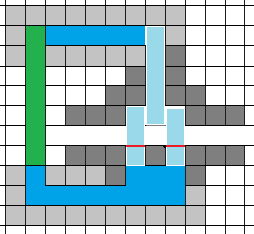You can keep water from muddying up the floor by giving it a further drop through the grate. If there is 7/7 right under the grate maybe some water will hit it and go sideways onto the floor but while it is falling it only moves straight down so if it is still falling after the grate you're fine.
The 3x3 grate is a not go though. Grates don't support so if you try to build that middle grate it will just fall.
You could easily make 2 1x3 lines of grates (or even 2x3 if you want to be sure.) But if you have the water falling on that 1x3 solid floor line just maybe it will get too deep for a moment and they will get upset canceling a lot of jobs. You can keep that floor dry by having floors one level up for the water to move off of onto either row of grates. With just one set of pumps supplying this you should get a lot of mist, a fair deal of water taking dust and things off of your dwarves, and possibly no job cancellations (the tile of falling water is so brief- I don't think it interfered with their pathing before.)
Edit:

So I did light gray and dark gray for the walls but one is further back. The pump stack haws already been explained so I didn't put any detail into that. Once you know how to do it making it taller doesn't take any thinking. Red is for grates, light blue is anywhere you will have falling water, dark blue will be standing water.
If I had thought of it sooner I'd only have dark gray for the places you want to have the same thing for three rows. It would work the way I drew it but you don't need it for the top section of falling water. You just want the floor it falls onto 3 wide so if can spread out when it hits it.
You could also easily place an overflow if you were worried about that (which I would use to initially fill the thing.)
Because water doesn't do pressure through diagonals you can just dig a shaft straight down to the height you want water and then make it move through a diagonal. The water will flow out through the diagonal pretty quick because that is 7/7 next to 0/7, especially if the next tile is a fall into the basin.
*For efficiency you can get away with around 12 tiles before the water flow really starts to slow down.
Now, do recognize that the water level is going to go down a bit when you run the pump stack. Each one can potentially take a full 7/7 tile and stick it in the tile behind them so you would have up to one tile per pump taken out of the basin. Likewise however many tiles from the top pump to where the water starts to fall will probably be just about 7/7. If you let the diagonal auto-fill your basin it is going to keep it full but you will have all this extra water around. All in all the water that is flowing would probably fill more than the 6 open tiles the way I have drawn this. (9 if you make the middle row of blocks just floors.)
There are 3 (4) options. You can dig drainage on the level that is supposed to be open. As long as you have somewhere for the water to go this is fine and really it would only be used for a second if you turn the pumps off.
Or you can install a floodgate at the input. If you hook that up to a level and close it once the basin is full you know that it has room for all of the water that is moving around. You should see very little evaporation while it is running but after a long time you might want to turn it off to let everything settle then open up the flood gate again to replenish it.
Or you could widen the open level and top level of the basin. This gives more room for any extra water and bumps up the capacity of your basin at just normal fill. (Taller works too but you'll need another pump.)
Personally I do the floodgate.

 Author
Topic: Artificial Cistern-Based Waterfall (Read 2862 times)
Author
Topic: Artificial Cistern-Based Waterfall (Read 2862 times)

